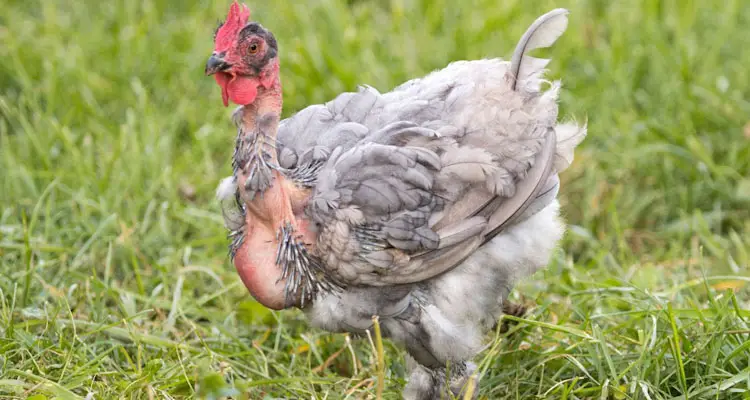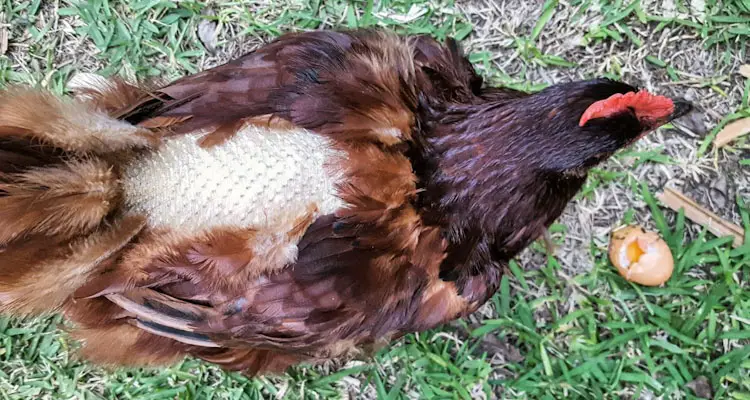Generally, chickens molt around late spring or early fall when there is a change in temperature or daylight hours. Molting usually takes only a few weeks, after which your chickens should return to normal with beautiful new feathers.
However, some chickens might show signs of molting outside of this period, which could cause some concern. Especially if it’s only one or two out of an entire flock.
Please don’t panic… Other factors, such as age, breed, or conditions inside the coop, might contribute to the irregularity.

Keeping this in mind, you should observe your chickens’ habits to recognize their molting period since egg production is also affected by it.
In this article, we are going to answer some essential questions, including:
- What Is Molting?
- When Do Chickens Molt?
- 2 Main Types Of Molting
- A Chicken’s Molting History
- What Causes Molting
- Helping Your Chickens Through Molting
Note: Use the links above to jump to the exact section you're interested in. We really hope this article will give you some peace of mind.
What Is Molting?
To begin with, it’s worth defining the term “molting” before getting into the specific details.
In short, “molting” is a period where chickens will start to lose their feathers and begin to grow new ones. By the end of the molting period, the chicken should have a coat with plenty of fresh feathers, with all the lost ones having been regrown.
However, the production of the new feathers takes a lot of their energy and nutrient storage. This means they will only be able to do little else while growth is happening.
In fact, feathers are made up of 85% protein. Regrowing them will take up much of the chicken’s energy, resulting in either a slowdown or a complete stop of egg production because they don’t have the power to keep it up.
This means you should plan around the molting season, supplementing with additional protein and other nutritious food so that your egg-production needs aren’t affected too much.
When Do Chickens Molt?
As mentioned in the introduction, the typical molting period for chickens is in the spring or the final parts of summer, when the weather starts to get cold.
However, you might come across chickens that don’t respect the traditional molting period, instead losing and regrowing their feathers at unpredictable times of the year.

It’s essential to look out for this since these changes could be misinterpreted as bullying or signs of an illness, like chicken mites, rather than off-season molting.
In cold climates, chickens can have many problems if they molt at the wrong time.
For one, they might find themselves featherless when the weather is freezing, which is terrible for their health. Additionally, it might affect your egg production schedules.
2 Main Types Of Molting
With that said, there are two different types of molting for chickens: soft and hard.
Soft molting is when the chicken loses a few feathers. Yet still, they look as if nothing is happening until a much closer inspection.
Usually, you’ll see many fluffy feathers around the coop. In some instances, broody hens use these soft feathers in their nest.
Hard molting is a much more noticeable change, with loads of feathers being lost and the animal looking entirely featherless.
In some cases, chickens might look like they are being bullied, with bald patches across its back.
A Chicken’s Molting History
Molting is crucial for a chicken because it removes its old and worn-down feathers. Then replace them with new and healthy ones, which helps keep the chickens sufficiently warm during the coldest times of the year.
However, not all molting is directly related to the weather. For example, a chicken’s first molt should happen when the newborn chicks are just 6-8 days old, while the first adult molt for a chicken comes at around 18 months.
During the first “juvenile” molt, the little chick loses its fuzzy downy coat of feathers and replaces it with real feathers – the kind it will keep getting for the rest of its life.
The chicken’s second juvenile molt will happen between 8 and 12 weeks of age, with the animal getting rid of its first baby feathers and growing a second set of them.
Note: Male chickens will begin to get their ornamental feathers. Sometimes, this second molt is when people find out that their chicken is a rooster.
What Causes Molting
For adult chickens, molting usually signals the end of an egg-laying cycle and fewer daylight hours. With that being said, other factors can cause molting, which typically makes a chicken molt out of the regular season.
Food and drink affect molting. If a chicken is malnourished or not getting enough water, then it can cause molting to begin.
On top of that, the weather can also affect the molting period. If a chicken is under extreme amounts of heat for prolonged periods, it could force its molting process to begin.
Similarly, if their lighting conditions change suddenly or they are under physical stress, they may also begin to molt.
Helping Your Chickens Through Molting
Since feathers contain 85% protein, you must provide your chicken with extra protein to compensate for the loss.
Give them protein-heavy treats (like mealworms, black soldier flies, nuts, and sunflower seeds) and use broiler feed if necessary.
Additionally, a featherless chicken with a hard molt can get bullied, so protecting them is essential.
Final Thoughts
Chicken molting is a normal process, but it’s essential to recognize and assist the animals through it.
However, if it occurs unexpectedly, you should not panic but seek to understand why it is happening.
Nevertheless, it would be best if you took some time to monitor your flock’s behavior and cater to their nutritional and environmental needs.
References
School Of Veterinary Medicine & Biomedical Sciences. Hen Molting: What To Egg-Spect. vetmed.tamu.edu. Accessed November 2022
Mississippi State University. Molting Of Laying Hens. extension.msstate.edu. Accessed November 2022
